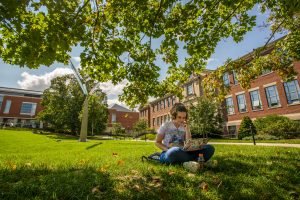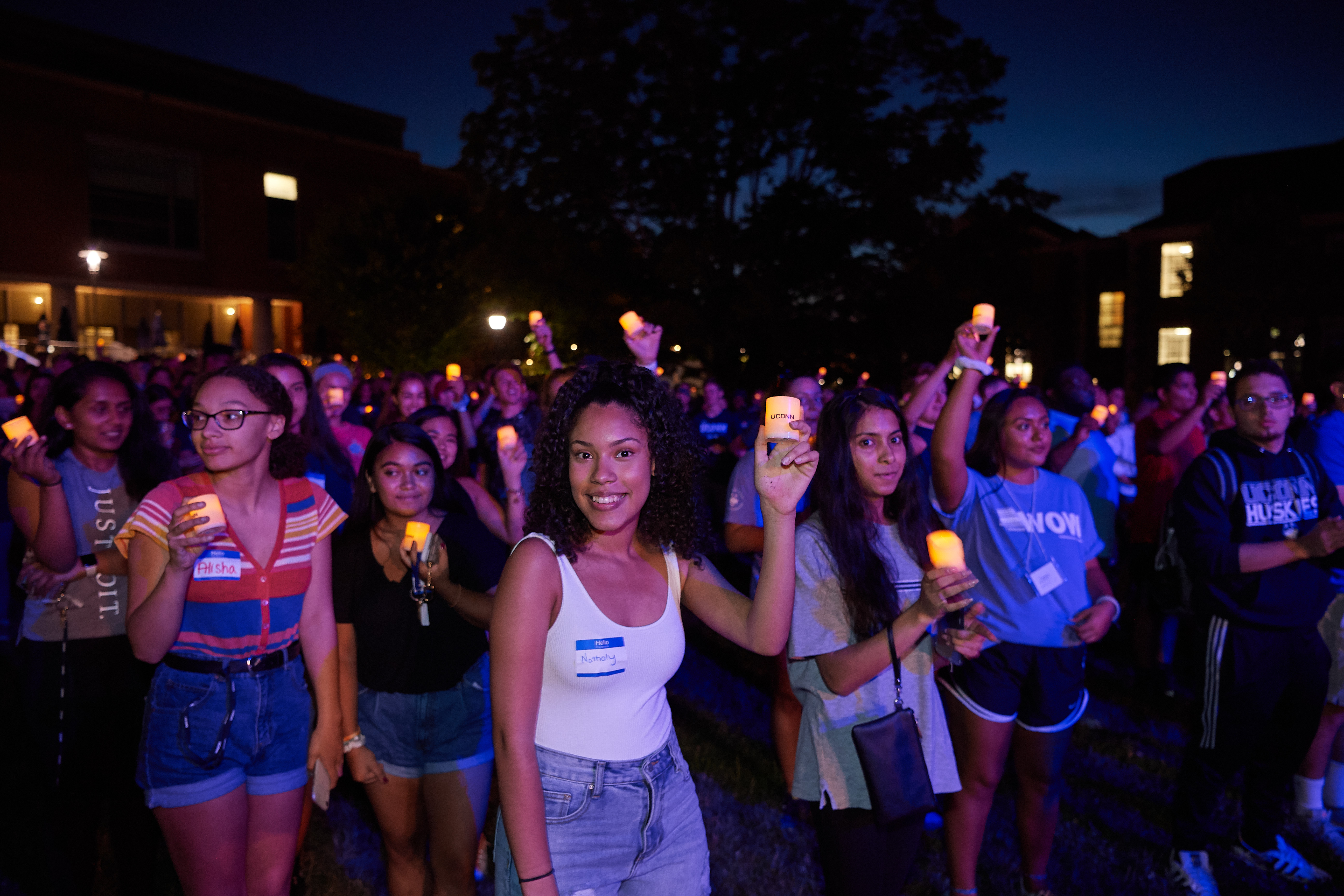Thousands of potential Huskies are celebrating admissions offers this month, rising to the top of an extremely competitive pool with a record number of undergraduate applications from around the world.
UConn received more than 48,000 applications for its Class of 2027 for Storrs applicants, a significant jump from last year’s approximately 43,000 — continuing a trend in which the University’s appeal has grown so strong that each year’s tally exceeds the last.
The applicant growth was strong in all categories: Connecticut residents, high schoolers from other states, and aspiring students from other nations. The applicant pool’s diversity is also again at an all-time high, with strong interest from underrepresented racial and ethnic populations and students who would be the first in their families to attend college.
“Interest in UConn’s programs and opportunities has never been stronger, and the growth in applications represents that,” says Vern Granger, UConn’s director of undergraduate admissions.
Admissions offers and details about financial aid awards started going out to Storrs campus applicants in recent days, and will continue in coming days and weeks for those who were late applicants.
About 4,100 new students are expected to enroll at Storrs, with notable areas of growth in nursing, computer science, and business.
“While the decision whether to enroll is now in the hands of the students and their families, our team at UConn is focusing on helping them get to know the school’s many offerings through its many events for admitted students,” says Nathan Fuerst, UConn’s vice president for enrollment planning and management.

“They have impressed us with their talent and ambition, and we look forward to impressing them with all of the ways in which UConn can provide an enriching, transformational experience to help them reach their goals and their full potential,” he says.
In addition to the Storrs-students, about 1,675 other new first-year students are anticipated at the regional campuses in Hartford, Stamford, Waterbury, and Avery Point.
The application period for those campuses runs through May 1, and students wishing to transfer from another institution to UConn have until April 1 to apply unless they sought admission to certain programs with earlier deadlines.
Like the Storrs applicants, students seeking to enroll in a regional campus or who already have received admission offers for one of those locations will have many opportunities to learn more about the academics, student life experiences, and unique personality of each campus community.
Even through the pandemic-related uncertainty at the decade’s start and national uncertainty over economic conditions, UConn has continued to draw increasing numbers of applicants and shaped strong entering classes without compromising its academic rigor.
It also has steadily increased the number of first-generation students, students from underrepresented racial and ethnic backgrounds, and students from modest means who have benefited from UConn’s strong financial aid packages.
UConn’s applicant pool increases have bucked the national trend, in which many institutions have struggled to draw large applicant pools because the number of high school graduates has decreased.
And while the number of high school graduates in Connecticut has also dropped, reflecting national demographic trends, UConn remains highly attractive to in-state students and continues to draw from all corners of the state.
This year’s stellar growth in applications continues a trend that goes back to the mid-1990s, when the Connecticut General Assembly approved the first iteration of UConn 2000 to modernize the University’s campuses and set it on its current course as a national leader.

In 1996, the first year of UConn 2000, the University received 10,709 applications for admission to the Storrs campus.
It had almost doubled by 2006; now, this year’s figure of more than 48,000 represents an increase of almost 450% since fall 1996.
While expanding in its enrollment and academic scope, UConn has also intentionally and strategically shaped its financial aid program, recruitment and retention efforts, and other work to draw and keep talented Connecticut students whose financial circumstances might otherwise have presented real or perceived barriers.
Of particular note this year, in fact, UConn saw an increase of 7.7% over last year in applications from students in the 73 schools in Connecticut’s Alliance Districts, which comprise the largest populations of people with significant financial need.
UConn launched its Alliance Pathway program in 2021 to better connect with talented students in those districts, ensuring they receive information from their guidance counselors about UConn programs, financial aid, resources for first-generation college students, and other details.
The increase in applications from seniors in the Alliance Pathway school districts is particularly gratifying. That’s both because it follows an increase of 6.5% last year, and because it indicates that UConn is drawing broadly from the economic, ethnic, racial, and geographic backgrounds of the state’s citizenry – all of which helps build a strong and diverse workforce now and well into the future.
Interest from out-of-state students remains very strong and international student applications, which had been negatively impacted by the pandemic and associated travel restrictions, also continue to bounce back.
Health-related majors such as nursing and allied health continue to draw interest among applicants, as do the traditionally popular fields of psychology, business, biological sciences, engineering, and several liberal arts programs.
UConn is also continuing its pilot program in which undergraduate applicants can decide whether or not they wish to submit their SAT and/or ACT scores to be considered as part of the University’s holistic review.
UConn admissions officers use a wide variety of factors beyond SAT and ACT scores to assess applicants on a holistic basis, including the student’s academic performance, strength of coursework, involvement, and leadership qualities.
As was the case in the past few years, the test-optional policy also is believed to have encouraged applications from potential students who might otherwise not have considered UConn to be within reach.

Students may submit SAT and/or ACT results if they choose, but no admissions decisions were impacted, and no students were disadvantaged if a standardized test score was not provided. Applicants also continue to be automatically considered for merit scholarships and Honors Program eligibility regardless of whether test scores were submitted.
In addition to the approximately 4,100 first-year students expected to enroll at Storrs for fall 2023, UConn forecasts about 1,675 at the regional campuses: Stamford (690), Hartford (560), Waterbury (225), and Avery Point (200).
UConn also plans to enroll 900 transfer students from other institutions, of which about 700 will be based at Storrs.
UConn’s undergraduate student body comprises about 75 percent from Connecticut and about 25 percent from elsewhere, a balance that is expected to continue in the coming academic year.



